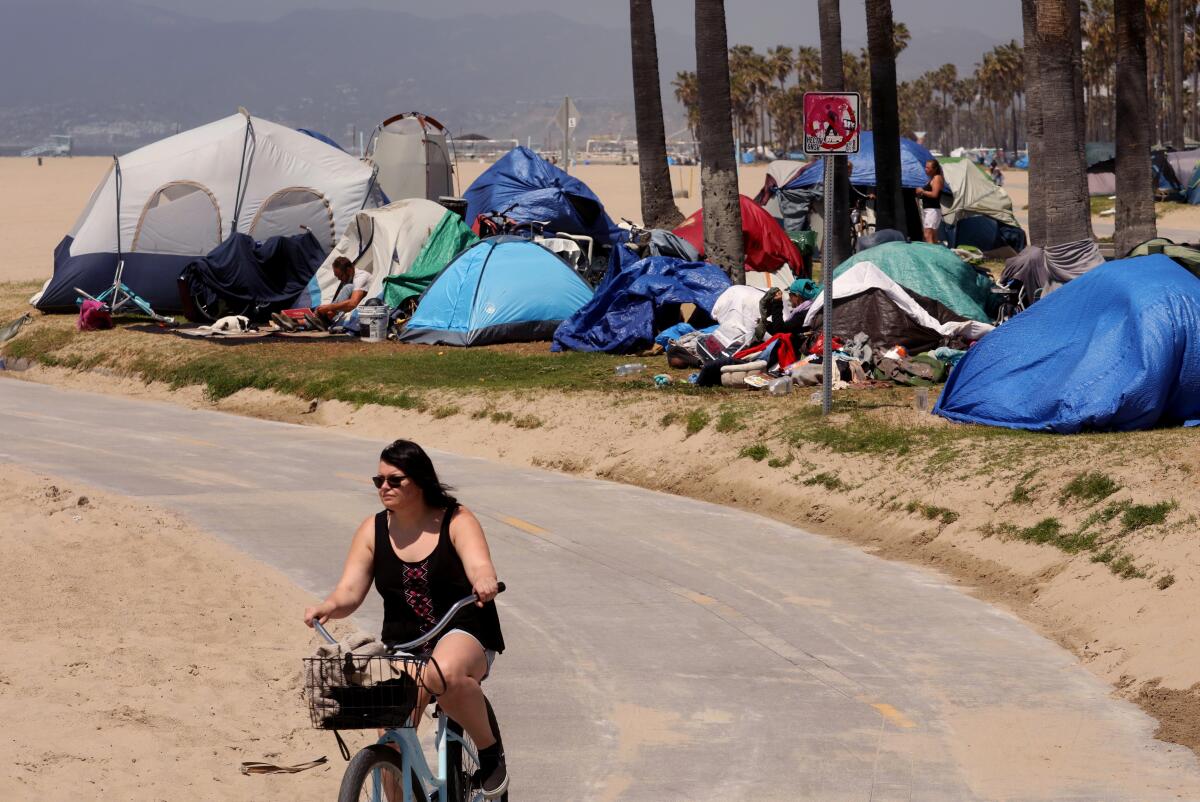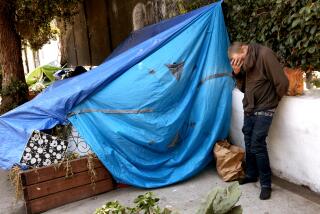Column: Beach apartments for homeless people? Venice residents are leery

- Share via
Maybe it was the house fire near a homeless encampment off Main Street in Venice that killed a beloved family dog.
Maybe it was the blaze that leaped from one of an estimated 223 tents on the Venice Boardwalk and destroyed a commercial building on Ocean Front Walk.
Or maybe it’s the surge in violent crime, the rash of stolen bicycles or videos of RVs dumping their sewage in the streets.
But Venice Beach, where I live, is on edge these days.
Next to downtown’s skid row, Venice has the largest population of unhoused people — an estimated 2,000 in three square miles. Their presence has become more visible over the last year because of the city’s decision not to enforce codes that forbid camping on sidewalks during the pandemic.
Homeowners and renters say they feel vulnerable, and they certainly have to cope with a lot. But no one is more vulnerable to catastrophic outcomes than the folks who through addiction, mental illness, sheer bad luck or choice sleep outside.
Part of the solution has got to be more housing, but that’s complicated in Venice. In 2017, the neighborhood was declared by the Wall Street Journal as one of the most difficult places in the country to add new housing units.
The ZIP Code 90291, said the Journal, “had about 700 fewer housing units in 2015 than in 2000, as apartment development stalled and wealthy homeowners gobbled up adjacent properties and leveled them. Home prices in the ZIP Code have more than tripled in those 15 years, rising 246% compared to the national average of 52% in the period.”
And never mind how many rental units had been taken off the market to be used as short-term rentals in the last few years. According to the website InsideAirbnb, the Venice Beach area has 2,053 short-term rental units, about 1,668 of which are entire homes or apartments.
You might think a proposal to build dozens of affordable apartments near the beach would be met with open arms by socially conscious Venice denizens. But that’s not what happened last week when the Los Angeles Planning Commission held a contentious public hearing on a new housing project one block from the beach. A collaboration between the Venice Community Housing Corp. and the Hollywood Community Housing Corp., the $75-million project would consist of a low-rise complex of about 140 apartments for formerly homeless and low-income people, as well as some work/live spaces for low-income artists, support staff for tenants, a coffee shop on the ground floor and a 3,000-square-foot performance space/community room named for the late, great dancer and actor Gregory Hines, a longtime Venice resident.
At the hearing, one neighbor compared the blocky-looking building to the U.K. Brutalist architecture movement of the 1950s, which he claimed was linked to suicides. Others claimed the location is in a flood zone. Commissioners, saying this is exactly the kind of project the city needs, voted unanimously to approve it, and it could break ground a little over a year from now if the L.A. City Council and California Coastal Commission approve it — and it doesn’t get tangled up in lawsuits.
Venice Community Housing Executive Director Becky Dennison is hopeful: “I think the city and the Planning Commission have been pretty strong the last few years in acknowledging the level of crisis,” she told me Tuesday. “They have been committed to affordable housing, and the use of city land is a key piece of addressing the crisis.”
Situated on the banks of the famous Grand Canal, sandwiched between North and South Venice boulevards at Pacific Avenue, the 2.6-acre city-owned site is currently a flat beach parking lot.
And though the parking lot is nothing special, like any expanse of open space, it offers a visual respite at a crowded intersection.
But increasingly, open space is an unaffordable luxury, as housing prices have skyrocketed, and Los Angeles has become crowded with homeless encampments.
Straddling the Grand Canal, which frankly is not so grand looking right now, the project would also provide parking for its residents, as well as a separate parking structure that will replace the lost surface beach parking lot.
Designed by the celebrated architect Eric Owen Moss, the complex would be typical of his work: harsh looking and somewhat bunker-like.
Moss is perhaps most famous for designing Culver City’s Hayden Tract, a jumble of eclectic and adventurous experimental buildings that replaced a bunch of decaying warehouses as part of that city’s redevelopment effort.
The Los Angeles Conservancy describes Moss as a “deconstructivist,” whose designs are “striking and distinctive sculptures of metal, cement, and glass that almost defy categorization.”
During the public comments portion of the Planning Commission’s meeting last week, opponents were far less flattering. They described the design as “hideous,” “a looming mass” and “atrocious.”
Brian Averill of the Venice Neighborhood Council told commissioners that his group unanimously opposed the project, which he described as a remarkable feat for a group that rarely agrees on anything. A group called Fight Back Venice has dubbed it “the Monster on the Median” and has vowed to take legal action, challenging the claim that the project is exempt from environmental review under a 2019 state law that was enacted to bypass onerous development requirements in the midst of an affordable housing crisis.
And yet, just as many Venetians spoke out in favor of the project as spoke against it.
“We are in a dire housing crisis,” said Linda Lucks, a local housing activist and former president of the Venice Neighborhood Council.
As for the design, she told me, “Beauty is in the eye of the beholder, and the one thing about design is you can’t legislate taste.’”
That is certainly true.
And as ungainly as I find the design, I find the sight of human beings living on the streets far, far uglier.
@AbcarianLAT
More to Read
A cure for the common opinion
Get thought-provoking perspectives with our weekly newsletter.
You may occasionally receive promotional content from the Los Angeles Times.











